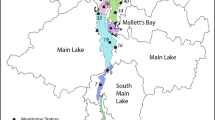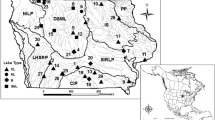Abstract
Mercury (Hg) contamination of fisheries is a major concern for resource managers of many temperate lakes. Anthropogenic Hg contamination is largely derived from atmospheric deposition within a lake’s watershed, but its incorporation into the food web is facilitated by bacterial activity in sediments. Temporal variation in Hg content of fish (young-of-year yellow perch) in the regulated lakes of the Rainy–Namakan complex (on the border of the United States and Canada) has been linked to water level (WL) fluctuations, presumably through variation in sediment inundation. As a result, Hg contamination of fish has been linked to international regulations of WL fluctuation. Here we assess the relationship between WL fluctuations and fish Hg content using a 10-year dataset covering six lakes. Within-year WL rise did not appear in strongly supported models of fish Hg, but year-to-year variation in maximum water levels (∆maxWL) was positively associated with fish Hg content. This WL effect varied in magnitude among lakes: In Crane Lake, a 1 m increase in ∆maxWL from the previous year was associated with a 108 ng increase in fish Hg content (per gram wet weight), while the same WL change in Kabetogama was associated with only a 5 ng increase in fish Hg content. In half the lakes sampled here, effect sizes could not be distinguished from zero. Given the persistent and wide-ranging extent of Hg contamination and the large number of regulated waterways, future research is needed to identify the conditions in which WL fluctuations influence fish Hg content.





Similar content being viewed by others
References
Benoit J, Gilmour C, Heyes A, Mason RP, Miller CL (2003) Geochemical and biological controls over methylmercury production and degradation in aquatic ecosystems. In: Chai Y, Braids OC (eds) Biogeochemistry of environmentally important trace elements, ACS Symposium Series #835. American Chemical Society, Washington, DC, pp 262–297
Bodaly RA, Hecky RE, Fudge RP (1984) Increases in fish mercury levels in lakes flooded by the Churchill River Diversion, Northern Manitoba. Can J Fish Aquat Sci 41:682–691
Bodaly RA, Beaty K, Hendzel L et al (2004) Experimenting with hydroelectric reservoirs. Environ Sci Technol 38:346A–352A
Burnham KP, Anderson DR (1998) Model selection and inference a practical information-theoretic approach. Springer, New York
Driscoll CT, Han Y-J, Chen CY, Evers DC, Lambert KF, Holsen TM, Kamman NC, Munson RK (2007) Mercury contamination in forest and freshwater ecosystems in the Northeastern United States. Bioscience 57:17–28. doi:10.1641/B570106
Driscoll CT, Mason RP, Chan HM, Jacon DJ, Pirrone N (2013) Mercury as a global pollutant: sources, pathways, and effects. Environ Sci Technol 47:4967–4983. doi:10.1021/es305071v
EPA (Environmental Protection Agency) (1991) Methods for the determination of metals in environmental samples, p 293
Essington T, Houser J (2003) The effect of whole-lake nutrient enrichment on mercury concentration in age-1 yellow perch. Trans Am Fish Soc 132:57–68
Evers D, Han Y, Driscoll C et al (2007) Biological mercury hotspots in the northeastern United States and southeastern Canada. Bioscience 57:29–43
Gilmour C, Krabbenhoft D, Orem W, Aiken G (2004) 2004 Consolidated report. Appendix 2B-1, p 127
Harris RC, Rudd JWM, Amyot M et al (2007) Whole-ecosystem study shows rapid fish-mercury response to changes in mercury deposition. Proc Natl Acad Sci USA 104:16586–16591. doi:10.1073/pnas.0704186104
Kallemeyn LW, Holmberg KL, Perry JA, Odde BY (2003) Aquatic synthesis for Voyageurs National Park: U.S. Geological Survey, Information and Technology Report 2003-0001, p 95
Kelly CA, Rudd JWM, Bodaly RA et al (1997) Increases in fluxes of greenhouse gases and methyl mercury following flooding of an experimental reservoir. Environ Sci Technol 31:1334–1344
Mailman M, Stepnuk L, Cicek N, Bodaly R (2006) Strategies to lower methyl mercury concentrations in hydroelectric reservoirs and lakes: a review. Sci Total Environ 368:224–235. doi:10.1016/j.scitotenv.2005.09.041
Munthe J, Bodaly RAD, Branfireun BA et al (2007) Recovery of mercury-contaminated fisheries. Ambio 1:33–44
NADP (2012a) NADP site information (MN18). http://nadp.sws.uiuc.edu/sites/siteinfo.asp?id=MN18&net=NTN. Accessed 8 Dec 2013
NADP (2012b) NADP Site Information (MN32). http://nadp.sws.uiuc.edu/sites/siteinfo.asp?net=NTN&id=MN32. Accessed 8 Dec 2013
Sandheinrich MB, Wiener JG (2011) Methylmercury in freshwater fish: recent advances in assessing toxicity of environmentally relevant exposures. In: Beyer WN, Meador JP (eds) Environmental contaminants in biota: interpreting tissue concentrations, 2nd edn. CRC Press, Boca Raton, FL, pp 169–192
SAS (2011) SAS Online
Selch TM, Hoagstrom CW, Weimer EJ et al (2007) Influence of fluctuating water levels on mercury concentrations in adult walleye. Bull Environ Contam Toxicol 79:36–40
Snodgrass J, Jagoe C, Bryan A et al (2000) Effects of trophic status and wetland morphology, hydroperiod, and water chemistry on mercury concentrations in fish. Can J Fish Aquat Sci 57:171–180
Sorensen JA, Kallemeyn LW, Sydor M (2005) Relationship between mercury accumulation in young-of-the-year yellow perch and water-level fluctuations. Environ Sci Technol 39:9237–9243. doi:10.1021/es050471r
Verta M, Rekolainen S, Kinnunen K (1986) Causes of increased fish mercury levels in Finnish reservoirs. Pub Water Res Inst 65:44–71
Wiener JG, Krabbenhoft DP, Heinz GH, Scheuhammer AM (2003) Ecotoxicology of mercury. In: Hoffman DJ, Rattner BA, Burton GA, Cairns J (eds) Handbook of ecotoxicology, 2nd edn. CRC Press, Boca Raton, FL, pp 409–463
Wiener JG, Knights BC, Sandheinrich MB et al (2006) Mercury in soils, lakes, and fish in Voyageurs National Park (Minnesota): importance of atmospheric deposition and ecosystem factors. Environ Sci Technol 40:6261–6268. doi:10.1021/es060822h
Acknowledgments
Thanks to John Sorensen for comments on an earlier version of this manuscript and to Mark Brigham for assistance obtaining Hg and sulfate deposition data. Several anonymous reviewers provided constructive comments that improved the manuscript. Thanks to Robert Kratt for assistance with Fig. 1. Any use of trade, product, or firm names is for descriptive purposes only and does not imply endorsement by the U.S. Government.
Conflict of interest
The authors declare that they have no conflict of interest.
Author information
Authors and Affiliations
Corresponding author
Electronic supplementary material
Below is the link to the electronic supplementary material.
10646_2014_1296_MOESM1_ESM.xlsx
S1. Data appendix. Raw data and site descriptions are included in this spreadsheet file. Also included are all parameter estimates from the model selection procedure. Supplementary material 1 (XLSX 613 kb)
10646_2014_1296_MOESM2_ESM.docx
S2–S13. Precision-adjusted, lake × year-level residuals (units = those of YOY perch Hg) from the base model (lake effects) and the AIC best model (lake-specific effects of ∆maxWL) and average summer pH, water temperature and Chl a, Secchi depth measured on-site, annual sulfate deposition and annual Hg deposition. Supplementary material 2 (DOCX 1398 kb)
Rights and permissions
About this article
Cite this article
Larson, J.H., Maki, R.P., Knights, B.C. et al. Can mercury in fish be reduced by water level management? Evaluating the effects of water level fluctuation on mercury accumulation in yellow perch (Perca flavescens). Ecotoxicology 23, 1555–1563 (2014). https://doi.org/10.1007/s10646-014-1296-5
Accepted:
Published:
Issue Date:
DOI: https://doi.org/10.1007/s10646-014-1296-5




